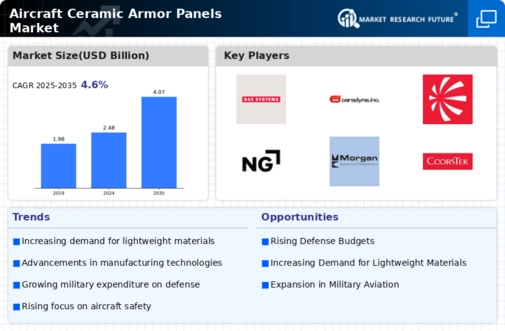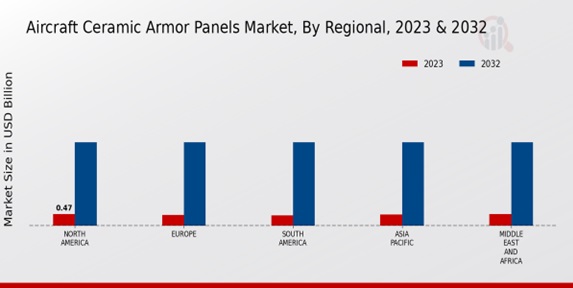Market Growth Projections
The Global Aircraft Ceramic Armor Panels Market Industry is projected to experience robust growth, with estimates indicating a market value of 2.48 USD Billion in 2024 and 4.07 USD Billion by 2035. This growth reflects a compound annual growth rate (CAGR) of 4.6% from 2025 to 2035. The increasing focus on military modernization, coupled with advancements in ceramic materials, is likely to drive this upward trend. As nations prioritize the protection of their air assets, the demand for advanced armor solutions will continue to rise, shaping the future landscape of the market.
Increasing Defense Budgets
The Global Aircraft Ceramic Armor Panels Market Industry is experiencing growth driven by rising defense budgets across various nations. Countries are increasingly investing in advanced military technologies to enhance their defense capabilities. For instance, the United States has allocated substantial funds for military modernization, which includes the integration of advanced armor systems in aircraft. This trend is not limited to the US; nations such as India and China are also ramping up their defense expenditures. As a result, the market is projected to reach 2.48 USD Billion in 2024, reflecting a growing demand for ceramic armor solutions in military aviation.
Rising Geopolitical Tensions
The Global Aircraft Ceramic Armor Panels Market Industry is influenced by escalating geopolitical tensions that prompt nations to bolster their military capabilities. Conflicts in various regions, such as Eastern Europe and the South China Sea, have led to increased military readiness and procurement of advanced defense systems. Countries are prioritizing the protection of their air assets, thus driving demand for ceramic armor panels. This trend is likely to sustain the market's growth trajectory, as nations seek to enhance the survivability of their aircraft in hostile environments, further supporting the projected CAGR of 4.6% from 2025 to 2035.
Growing Demand for Military Aircraft
The Global Aircraft Ceramic Armor Panels Market Industry is benefiting from the increasing demand for military aircraft. As nations modernize their air fleets, there is a corresponding need for advanced protective measures, including ceramic armor panels. The rise in military aircraft production, driven by both new orders and upgrades to existing fleets, underscores the necessity for enhanced protection against evolving threats. This demand is expected to contribute to the market's growth, with projections indicating a market value of 2.48 USD Billion in 2024, as military forces prioritize the integration of advanced armor solutions.
Technological Advancements in Materials
Innovations in materials science are significantly impacting the Global Aircraft Ceramic Armor Panels Market Industry. The development of lightweight, high-strength ceramic composites enhances the performance of armor panels, making them more effective against various threats. For example, advancements in boron carbide and silicon carbide ceramics have led to improved ballistic resistance while reducing weight. This is particularly crucial for military aircraft, where weight reduction can enhance fuel efficiency and maneuverability. As these technologies continue to evolve, they are expected to drive market growth, contributing to an anticipated market value of 4.07 USD Billion by 2035.
Emerging Markets and Defense Collaborations
Emerging markets are playing a pivotal role in the Global Aircraft Ceramic Armor Panels Market Industry. Countries in regions such as Asia-Pacific and the Middle East are increasingly collaborating with established defense manufacturers to enhance their military capabilities. These collaborations often focus on the development and procurement of advanced armor technologies for aircraft. As these nations seek to modernize their defense forces, the demand for ceramic armor panels is expected to rise. This trend is indicative of a broader shift in global defense dynamics, potentially leading to a market value of 4.07 USD Billion by 2035.






















